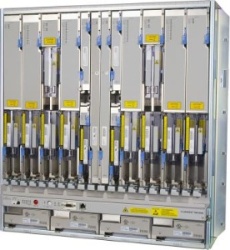Mar 19 2010
Fujitsu, a leading provider of business, information technology, and communications solutions, announced today the addition of third generation 40 Gbps optical interfaces to its industry leading FLASHWAVE® 7500 Reconfigurable Optical Add/Drop Multiplexer (ROADM) platform.
 Fujitsu FLASHWAVE 7500 ROADM
Fujitsu FLASHWAVE 7500 ROADM
Coherent receivers offer many advantages, including improved optical performance, which allows for larger geographic networks with longer optical spans. Utilizing all-electronic compensation, coherent optics eliminate the need for dispersion compensation modules and improve operational flexibility.
“The market for 40G transport gear surpassed $500 million in 2009 as carriers around the globe embraced the technology,” said Ron Kline, principal analyst of network infrastructure at Ovum. “The latest Fujitsu 40G products respond to evolving and growing market needs for systems with higher tolerance to dispersion while at the same time shortening the 100G developmental cycle. We expect the market for 40G to double this year and exceed $3 billion by 2014.”
The market-leading FLASHWAVE 7500 ROADM is a complete optical hubbing and transport solution widely deployed in traditional telecom carrier and cable operator networks to support core network consolidation, metro/regional capacity relief, and triple-play service delivery. Globally deployed in North America, Europe, and Asia, the FLASHWAVE 7500 platform is available in ANSI and ETSI configurations. Network topology support spans from simple two-degree (2D) ROADM ring networks to advanced 12-degree optical hubbing/mesh applications. The system supports network sizes of up to 1200 km, up to 24 add/drop nodes per network, and a capacity of up to 1.6 Tbps.
The new 40 Gbps coherent interfaces for the FLASHWAVE 7500 ROADM include individual transponder, muxponder, and regenerator units. Combining advanced coherent detection technology with dual polarization quadrature phase shift keying (DP-QPSK) modulation, these new units enable enhanced performance on ultra-high speed 40 Gbps wavelength division multiplexing (WDM) networks.
“Fujitsu has been the leader in optical communications patents for four consecutive years thanks to our sizeable investment in core optical R&D,” said Bill Erickson, senior vice president of planning and development at Fujitsu Network Communications. “We first introduced 40 Gbps interfaces in 2007 and with the introduction of these third generation units, Fujitsu continues to back up our R&D investment with commercially available product innovations that significantly advance high-speed optical networking options.”
The second generation 40 Gbps interface cards, which are based on Adaptive Differential Phase Shift Keying (ADPSK) modulation, are still available and will continue to be offered and supported for applications that do not require the enhanced DP-QPSK / coherent performance.